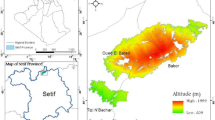Abstract
Long-term records of solar UV radiation reaching the Earth’s surface are scarce. Radiative transfer calculations and statistical models are two options used to reconstruct decadal changes in solar UV radiation from long-term records of measured atmospheric parameters that contain information on the effect of clouds, atmospheric aerosols and ground albedo on UV radiation. Based on earlier studies, where the long-term variation of daily solar UV irradiation was derived from measured global and diffuse irradiation as well as atmospheric ozone by a non-linear regression method [Feister et al. (2002) Photochem Photobiol 76:281–293], we present another approach for the reconstruction of time series of solar UV radiation. An artificial neural network (ANN) was trained with measurements of solar UV irradiation taken at the Meteorological Observatory in Potsdam, Germany, as well as measured parameters with long-term records such as global and diffuse radiation, sunshine duration, horizontal visibility and column ozone. This study is focussed on the reconstruction of daily broad-band UV-B (280–315 nm), UV-A (315–400 nm) and erythemal UV irradiation (ER). Due to the rapid changes in cloudiness at mid-latitude sites, solar UV irradiance exhibits appreciable short-term variability. One of the main advantages of the statistical method is that it uses doses of highly variable input parameters calculated from individual spot measurements taken at short time intervals, which thus do represent the short-term variability of solar irradiance.
















Similar content being viewed by others
References
Bais A, Kazantzidis S, Kazadzis S, Kouremeti N (2005) Application of a model derived cosine correction method on Brewer spectral measurements. Presented at the European Geosciences Union General Assembly, 24–29 April 2005, Vienna, Austria
Behrens K (2003) Die Variabilität der Globalstrahlung und Sonnenscheindauer in Potsdam. 6. Deutsche Klimatagung, Berlin, pp 40–46
Chevallier F, Cheruy F, Scott NA, Chedin A (1998) A neural network approach for a fast and accurate computation of a longwave radiative budget. J Appl Meteorol 37:1385–1397
Dehne K (1984) On the general applicability of a new correction formula for diffuse solar radiation measured by shade ring devices. In: Congress Proceedings, Meteorologie et Energies Renouvables, 13–16 March 1984, Valbonne, France, pp 73–87
Dovlo ASS, Jervase JA, Al-Lawati A (2002) Solar radiation estimation using artificial neural networks. Appl Energy 71:307–319
Elizondo D, Hoogenboom G, McClendon RW (1994) Development of a neural network model to predict daily solar radiation. Agric For Meteorol 71:115–132
Feister U, Grewe R, Gericke K (1997) A method for correction of cosine errors in measurements of spectral UV irradiance. Sol Energy 60:313–332
Feister U, Jäkel E, Gericke K (2002) Parameterization of daily solar global ultraviolet irradiation. Photochem Photobiol 76:281–293
Feister U, Kaifel A, Grewe RD, Kaptur J, Reutter O, Wohlfart M, Gericke K (2005) Fast measurements of solar spectral irradiance-first performance results of two novel spectroradiometers. Opt Eng 44:041007-1–041007-9
Josefsson W (2006) UV-radiation 1983–2003 measured at Norrköping, Sweden. Theor Appl Climatol 83:59–76
Junk J, Feister U (2006) Efficiency of a neural network to model and predict daily values of UV irradiation based on measurements of meteorological parameters and atmospheric ozone at Lindenberg, Germany. SCOUT-O3 Annual Meeting 20–24 March 2006, Jülich, Germany
Lindfors A, Vuilleumier L (2005) Erythemal UV at Davos (Switzerland), 1926–2003, estimated using total ozone, sunshine duration, and snow depth. J Geophys Res D: Atmosphere 110:1–15
Lopez G, Rubio MA, Martinez M, Battles M (1998) Estimation of hourly global photo synthetically active radiation using artificial neural network models. Agric For Meteorol 107:279–291
McClelland JL, Rumelhart DE (1986) Parallel distributed processing: explorations in the microstructure of cognition. Vol. I: foundations and vol. II: psychological and biological models. MIT Press, Cambridge
McKinley AF, Diffey BL (1987) A reference spectrum for ultraviolet induced erythema in human skin. CIE-J 6:17–22
Mohandes M, Rehman S, Halawani TO (1998) Estimation of global solar radiation using artificial neural networks. Renew Energy 14:179–184
Reddy KS, Ranjan M (2003) Solar resource estimation using artificial neural networks and comparison with other correlation models. Energ Convers Manag 44:2519–2530
Sanchez-Mesa JA, Galan C, Hervas C (2005) The use of discriminant analysis and neural networks to forecast the severity of the Poaceae pollen season in a region with a typical Mediterranean climate. Int J Biometeorol 49:355–362
Schöne W, Sonntag D (1976) Die Schattenringkorrektion beim Pyranometer mit galvanisch erzeugter Thermosäule. Z Meteorol 26:48–52
Slaper H, Reinen HAJM, Blumthaler M, Huber M, Kuik F (1995) Comparing ground-level spectrally resolved solar UV measurements using various instruments: a technique resolving effects of wavelength shift and slit width. Geophys Res Lett 22:2721–2724
Sonntag D (1989) Formeln verschiedenen Genauigkeitsgrades zur Berechnung der Sonnenkoordinaten. Abh. Meteorol. Dienstes der DDR 143. Akademie, Berlin
Spänkuch D, Schulz E, Feister U, Plessing P (1999) Climatology of total ozone measurements 1964–1997 at Potsdam, based on re-evaluated Dobson series. Ber Dtsch Wetterdienstes 206:1–97
Woldt M (2006) Aufbereitung und Auswertung bodengebundener Strahlungs-und Bewölkungsmesswerte für die Rekonstruktion von UV-Strahlungsmessreihen sowie zur Validierung von Mess-Systemen. Internal Work Report, May 2006, DWD-ROA, pp 1–22
Acknowledgements
We gratefully acknowledge the support given by the European project “Stratospheric-Climate Links with Emphasis on the Upper Troposphere and Lower Stratosphere (SCOUT-O3), Activity 4 UV radiation”, activity leaders A. Bais and G. Seckmeyer. Further, we would like to mention the support of the European COST726 action “Long term changes and climatology of UV radiation over Europe”, to which results of our model calculations and input data have been submitted. The contributions of M. Woldt, who derived daily totals of UV radiation from Brewer spectra, and K. Behrens, who provided the global and diffuse irradiance values, are also acknowledged.
Author information
Authors and Affiliations
Corresponding author
Rights and permissions
About this article
Cite this article
Junk, J., Feister, U. & Helbig, A. Reconstruction of daily solar UV irradiation from 1893 to 2002 in Potsdam, Germany. Int J Biometeorol 51, 505–512 (2007). https://doi.org/10.1007/s00484-007-0089-4
Received:
Revised:
Accepted:
Published:
Issue Date:
DOI: https://doi.org/10.1007/s00484-007-0089-4




